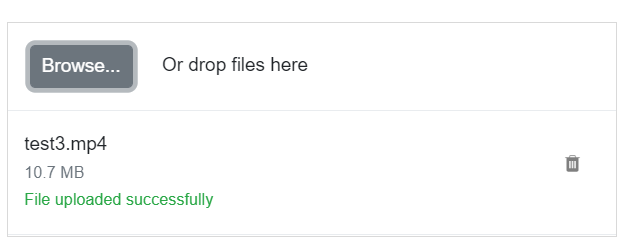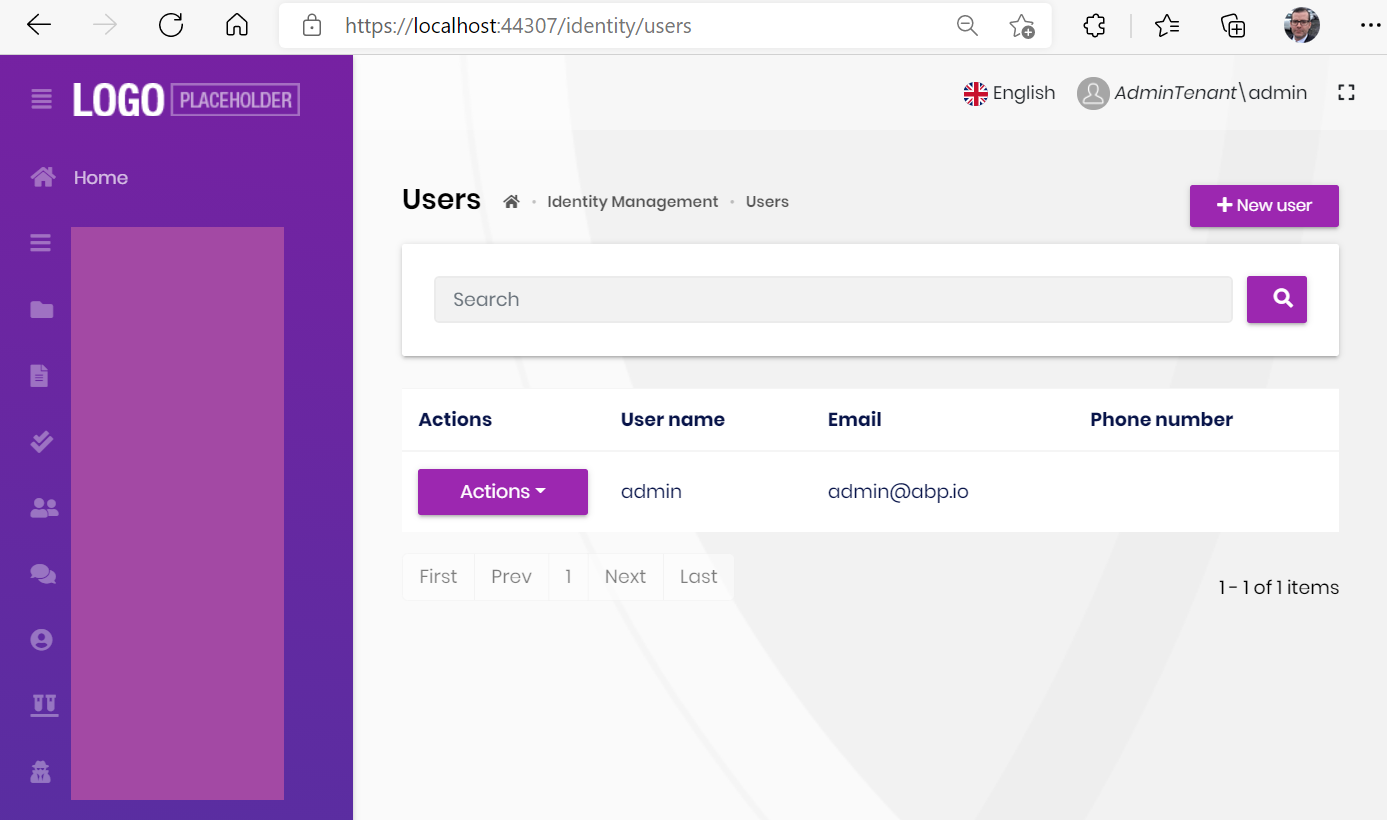For some reason I can't get data from Blazor to a controller but I can through SwaggerUI when using this Syncfusion File Upload component.
When in Blazor it only looks like I successfully upload a file

when in reality 0 file data gets transferred with no errors anywhere.. (nb.I have tried all kinds of attributes and [FromForm] etc that I seen suggested around the internet)

But it does WORK if I use the SwaggerUI
here you can see that I get content with using SwaggerUI

What is going on here and what do I need to do to make this work?
I´m trying to upload a big file using multipart request but using this framework I´m getting the following error
"Unexpected end of Stream, the content may have already been read by another component."
There is like something in Abp is "messing with" the communication and I can´t find out what.
I asked this question in details at GitHub but like to get some priority on it by posting it also here. Hope hearing from you soon.
I just noticed that the administration side menu has completely vanished! If I create a new tenant and log-in never shows up.
BUT I still can navigate to say /idenity/users and access the pages so its not any access control issue.
Here you can see that there is no Administration dropdown in the sidemenu (I know I should have cropped less from the names but trust me, its not there).

I have gone over everything multiple times and I can´t see anywhere that I´m to blame!
No problem sending someone my solution to check this out.
Hi
More details (images etc.) for my problem can be found as a comment to this gist for customising the Register page for the Account module.
But when I try to implement this I get the following errors when trying to customise the Lepton theme.
Uncaught ReferenceError: $ is not defined in ApplicationConfigurationScript
and
Uncaught ReferenceError: abp is not defined in ServiceProxyScript
There wasa support ticket that asked the same question but never had a resolution. I have gone over that and I can browse to the ServiceProxyScript and this is running locally and not in Azure and no errors in the logfiles in the IdentityServer.
Btw I'm using the source code for Volo.Account.Pro module (I haven´t changed it yet so its 100% the same) and therefor doing these changes in the IdentityServer and not the HttpApi.Host if that matters.
Any ideas or something for me to try out?
I´m trying out the module system by changing source code for the Account module (the login screen).
But I get when running the project I get the following error for the IdentityServer
Here is what I´m doing
abp add-module Volo.Account.Pro that adds nuget package references to 4 projects (Application,Contracts,Blazor,IdentityServer) and an [DependsOn(typeof(AbpAccountPublicWebModule))] to their respected *Module.cs classes.So I'm I missing somthing (and is it in the documentation?) or is something broken?
ABP Framework version: v4.3.2 (Suite 4.3.3) UI type: Blazor DB provider: EF Core Identity Server Separated: yes
p.s For others I will probably just follow "Customization Overriding Components" and "How to customize the login page of an ABP Blazor application" to customize the login window since the docs reccoment "If you want to make huge changes or add major features on a pre-built module, but the available extension points are not enough, you can consider to directly work the source code of the depended module" but I'm doing a small change at this time but will probably in the future.
e.s Changes done with "How to customize the login page of an ABP Blazor application" are not reflected in the login screen most likely because I have a separate identiyserver. So now I really need assistance with this!
Stacktrace
[09:43:56 FTL] .IdentityServer terminated unexpectedly!
System.IO.FileNotFoundException: Could not load file or assembly 'Volo.Abp.Account.Pro.Public.Web, Version=4.3.2.0, Culture=neutral, PublicKeyToken=null'. The system cannot find the file specified.
File name: 'Volo.Abp.Account.Pro.Public.Web, Version=4.3.2.0, Culture=neutral, PublicKeyToken=null'
at System.Reflection.CustomAttribute._CreateCaObject(RuntimeModule pModule, RuntimeType type, IRuntimeMethodInfo pCtor, Byte** ppBlob, Byte* pEndBlob, Int32* pcNamedArgs)
at System.Reflection.CustomAttribute.CreateCaObject(RuntimeModule module, RuntimeType type, IRuntimeMethodInfo ctor, IntPtr& blob, IntPtr blobEnd, Int32& namedArgs)
at System.Reflection.CustomAttribute.AddCustomAttributes(ListBuilder1& attributes, RuntimeModule decoratedModule, Int32 decoratedMetadataToken, RuntimeType attributeFilterType, Boolean mustBeInheritable, ListBuilder1 derivedAttributes) at System.Reflection.CustomAttribute.GetCustomAttributes(RuntimeType type, RuntimeType caType, Boolean inherit)
at System.RuntimeType.GetCustomAttributes(Type attributeType, Boolean inherit)
at System.Attribute.GetCustomAttributes(MemberInfo element, Boolean inherit)
at Volo.Abp.Modularity.AbpModuleHelper.FindDependedModuleTypes(Type moduleType)
at Volo.Abp.Modularity.AbpModuleHelper.AddModuleAndDependenciesResursively(List1 moduleTypes, Type moduleType, ILogger logger, Int32 depth) at Volo.Abp.Modularity.AbpModuleHelper.AddModuleAndDependenciesResursively(List1 moduleTypes, Type moduleType, ILogger logger, Int32 depth)
at Volo.Abp.Modularity.AbpModuleHelper.FindAllModuleTypes(Type startupModuleType, ILogger logger)
at Volo.Abp.Modularity.ModuleLoader.FillModules(List1 modules, IServiceCollection services, Type startupModuleType, PlugInSourceList plugInSources) at Volo.Abp.Modularity.ModuleLoader.GetDescriptors(IServiceCollection services, Type startupModuleType, PlugInSourceList plugInSources) at Volo.Abp.Modularity.ModuleLoader.LoadModules(IServiceCollection services, Type startupModuleType, PlugInSourceList plugInSources) at Volo.Abp.AbpApplicationBase.LoadModules(IServiceCollection services, AbpApplicationCreationOptions options) at Volo.Abp.AbpApplicationBase..ctor(Type startupModuleType, IServiceCollection services, Action1 optionsAction)
at Volo.Abp.AbpApplicationWithExternalServiceProvider..ctor(Type startupModuleType, IServiceCollection services, Action1 optionsAction) at Volo.Abp.AbpApplicationFactory.Create(Type startupModuleType, IServiceCollection services, Action1 optionsAction) at Volo.Abp.AbpApplicationFactory.Create[TStartupModule](IServiceCollection services, Action1 optionsAction) at Microsoft.Extensions.DependencyInjection.ServiceCollectionApplicationExtensions.AddApplication[TStartupModule](IServiceCollection services, Action1 optionsAction)
at .Startup.ConfigureServices(IServiceCollection services) in C:\Dev...\aspnet-core\src.IdentityServer\Startup.cs:line 10
at System.RuntimeMethodHandle.InvokeMethod(Object target, Object[] arguments, Signature sig, Boolean constructor, Boolean wrapExceptions)
at System.Reflection.RuntimeMethodInfo.Invoke(Object obj, BindingFlags invokeAttr, Binder binder, Object[] parameters, CultureInfo culture)
at Microsoft.AspNetCore.Hosting.ConfigureServicesBuilder.InvokeCore(Object instance, IServiceCollection services)
at Microsoft.AspNetCore.Hosting.ConfigureServicesBuilder.<>c__DisplayClass9_0.<Invoke>g__Startup|0(IServiceCollection serviceCollection)
at Microsoft.AspNetCore.Hosting.ConfigureServicesBuilder.Invoke(Object instance, IServiceCollection services)
at Microsoft.AspNetCore.Hosting.ConfigureServicesBuilder.<>c__DisplayClass8_0.<Build>b__0(IServiceCollection services)
at Microsoft.AspNetCore.Hosting.GenericWebHostBuilder.UseStartup(Type startupType, HostBuilderContext context, IServiceCollection services, Object instance)
at Microsoft.AspNetCore.Hosting.GenericWebHostBuilder.<>c__DisplayClass13_0.<UseStartup>b__0(HostBuilderContext context, IServiceCollection services)
at Microsoft.Extensions.Hosting.HostBuilder.CreateServiceProvider()
at Microsoft.Extensions.Hosting.HostBuilder.Build()
at .Program.Main(String[] args) in C:\Dev...\aspnet-core\src.IdentityServer\Program.cs:line 31
C:\Dev...\aspnet-core\src.IdentityServer\bin\Debug\net5.0.IdentityServer.exe (process 13924) exited with code 1.
Hi
Since this ticket is closed I´m forced to create a new one.
I have the exact problem with Blazor WASM 4.3.2, that the content on the Settings page is missing when logged in as tenant, but the suggested fix in the above ticket doesn´t solve it.
The following code doesn´t seem to do anything when placed (anywhere) in the Define() method in the PermissionDefinitionProvider class
var setting = context.GetPermissionOrNull(SettingManagementPermissions.Emailing);
setting.MultiTenancySide = MultiTenancySides.Both;
Am I missing something?
Here you can see the Settings menu item but totally empty page.
I need to implement the payment gateway provider Rapyd and I would like to know what is my best approach to it?
I see that the abp.io payment module only supports 4 gateways and not one of them supports my local currency (ISK).
What would you reccommend I should do?
Any change you could add Rapyd to the payment module?
See Growing At 400%, Rapyd Takes On PayPal In $160 Trillion B2B Payments Market
This is probably a two-fold but related question:
I have a page with data, that when saved, creates MyEvent. The page contains few things that I like to separate out (not be in the same table) so I can use it later somewhere else. See image at bottom
When I use Suite I create the following entities
where CommonId,SettingsId and GeoRestrictionId are navigation properties on MyEvent.
This way I can (in MyEventAppService) use the GetWithNavigationPropertiesAsync() method and get the related entities directly into the service (or GetAsync() if I just want the ids to query and use later).
So far so good?
If so then whats the best practice to create MyEvent with the navigationproperties in one go?
Would it be fine to do it like this in MyEventAppService? Will this use unit-of-work (if one insert fails all fails)?
[Authorize(MyPermissions.MyEvent.Create)]
public virtual async Task<MyEventDto> CreateAsync(MyEventCreateDto input)
{
var myEvent = ObjectMapper.Map<MyEventCreateDto, MyEvent>(input);
// Insert Common/Settings/GeoRestriction and get their id's
var commontemp = new Common(GuidGenerator.Create()){ Name = input.Common.Name, etc... }
var common = await _commonRepository.InsertAsync(commontemp, autoSave: true);
...
... same for Settings and GeoRestriction
// then "hook" it together by addin their ids to myEvent and save
myEvent.CommonId = common.Id;
myEvent.SettingsId = settings.Id;
myEvent.GeoRestrictionId = geoRestriction.Id;
myEvent.TenantId = CurrentTenant.Id;
myEvent = await _myEventRepository.InsertAsync(myEvent, autoSave: true);
return ObjectMapper.Map<MyEvent, MyEventDto>(myEvent);
}
I really feel like I have got this down just by writing the question but would like to know for sure.
I was wondering if there was a good way to delete related records, just like you can get all the records with WithDetailsAsync()?
Or will I just have to add all the services (of the related entities I want to delte) to the main one (channelAppService in my example) and iterate through them and manually delete each one (see example 1)?
/* code in my ChannelAppService */
public async Task<ChannelDto> GetWithDetailsAsync(Guid id)
{
//Get the related records General and Settings from _channelRepository
var queryable = await _channelRepository.WithDetailsAsync(x => x.General, x => x.Settings);
//Where Channel is == id
var query = queryable.Where(x => x.Id == id);
//Get Channel with General and Settings back
return ObjectMapper.Map<Channel, ChannelDto>(await AsyncExecuter.FirstOrDefaultAsync(query));
}
// What would be the recomended way to delete the related records of channel?
public async Task DeleteWithDetailsAsync(Guid id)
{
// 1. example
// But what if the first delete works but the rest fail?
_channelRepository.DeleteAsync(id);
_generalRepository.DeleteAsync(theGeneralId);
_settingsRepository.DeleteAsync(theSettingsId);
// 2. example
//OR is there simpler way like this maybe (with some more code obviously) ?
await AsyncExecuter.DeleteWithDetails(channel);
}
This must be fairly common to do so isn't there some examples you can share with me?
Hi
I'm getting CS0104 ambiguous reference errors when adding entities in Suite. Unique namespaces don´t seem to be enough.
Here are two examples of this
1.
First I had this one
C:\Dev\Test\aspnet-core\src\Test.EntityFrameworkCore\EntityFrameworkCore\TestEntityFrameworkCoreModule.cs(55,49): error CS0104: 'EfCoreLanguageRepository' is an ambiguous reference between 'Test.Languages.EfCoreLanguageRepository' and 'Volo.Abp.LanguageManagement.EntityFrameworkCore.EfCoreLanguageRepository' [C:\Dev\Test\aspnet-core\src\Test.EntityFrameworkCore\Test.EntityFrameworkCore.csproj]
For now, I´ll call it "OurLanguages" (or something.. naming is hard) but I would prefer it just being Language and the DB table AppLanguage.
2.
And now I just had this one that I find even stranger
error CS0104: 'TimeZone' is an ambiguous reference between 'Test.TimeZones.TimeZone' and 'System.TimeZone'
Why
Your ABP Framework version. 4.2.2 Your database provider: EF Core Blazor

